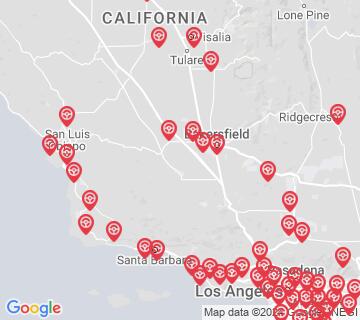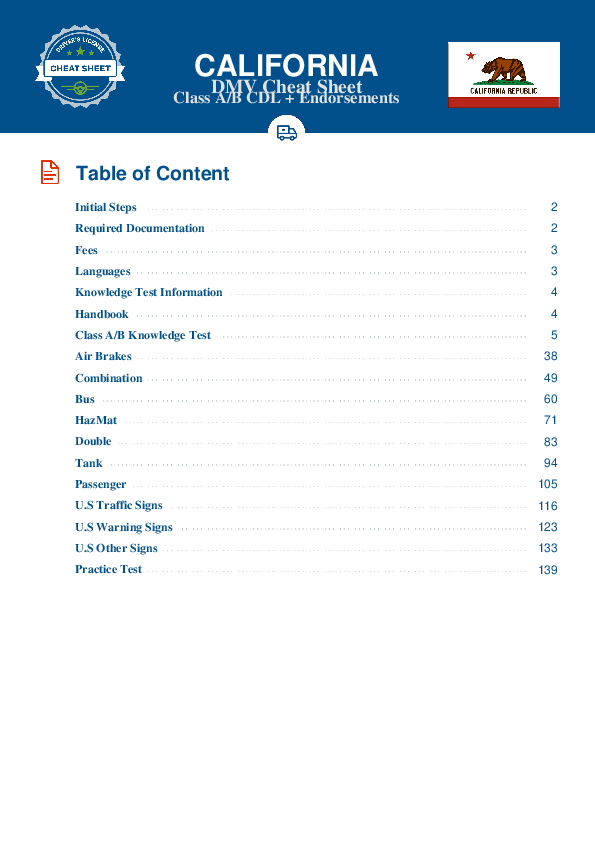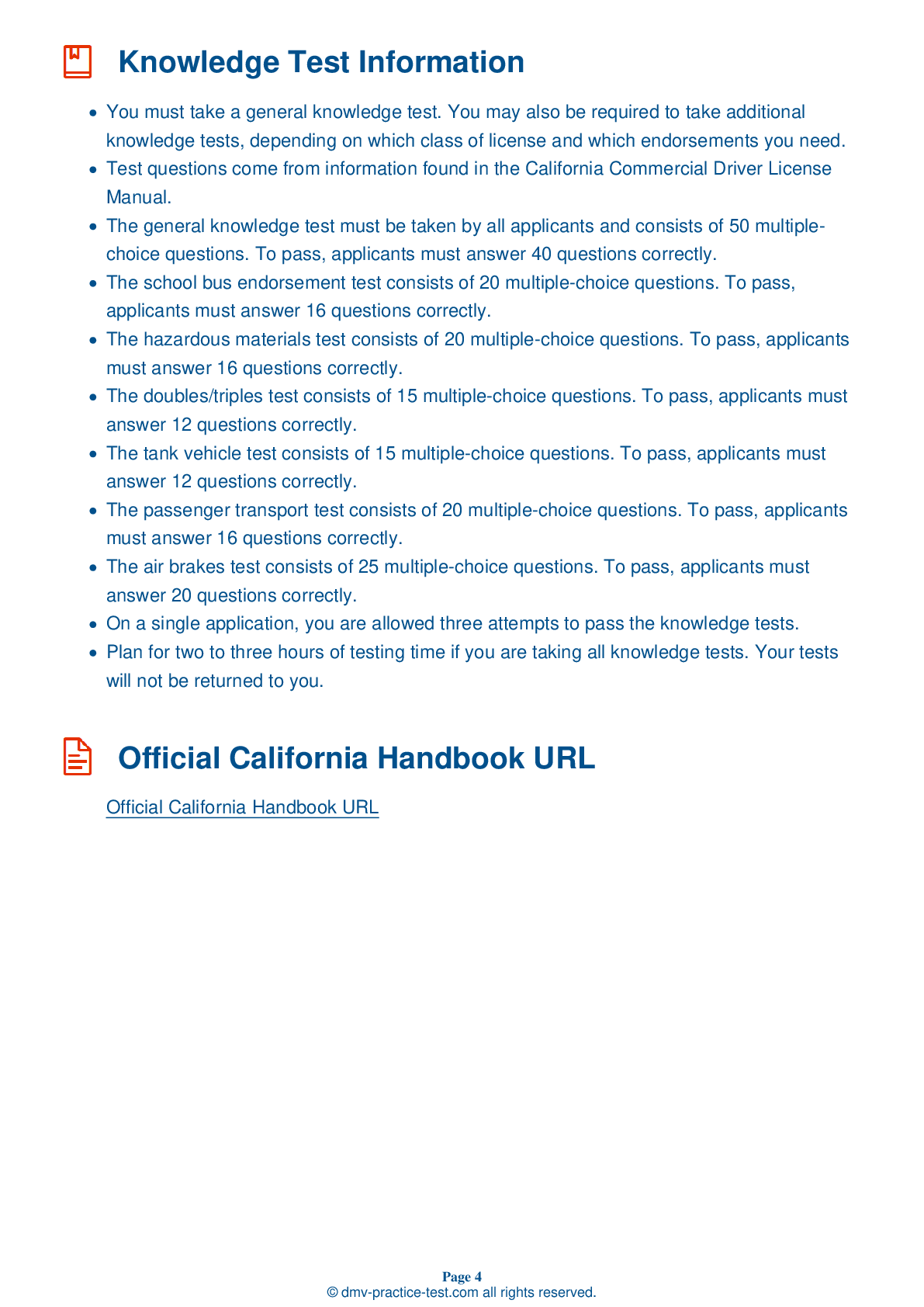HazMat #1
Hazmat Test | California 2025 #1
On our website, we provide FREE practice - CDL hazmat test online! The official exam test consists of several obligatory parts, with all of them checking your knowledge of different blocks of road rules. If you need to obtain a CA CDL hazmat endorsement in 2025, practice as much as possible. Free sample tests published on our website will help you check and improve your knowledge and boost your grades. Please bear in mind that California requirements for issuing a hazmat endorsement for CDL may vary from those established in other states.
20
16
20
1 . When carrying Division 1.1, 1.2, or 1.3 explosives, your vehicle should not be:
Except when parking briefly to perform necessary functions for vehicle operation (such as refueling), never park a vehicle carrying Division 1.1, 1.2, or 1.3 explosives within 300 feet of a bridge, tunnel, or building. Never park such a vehicle within five feet of the traveled portion of the road.
2 . If you're transporting explosives and your vehicle breaks down, you should notify other drivers:
If your vehicle breaks down while you are transporting explosives and you need to use warning signals, use reflective triangles or red electric lights. Never use burning signals, such as flares or fuses, when transporting explosives.
3 . The power unit of a placarded vehicle must carry a fire extinguisher with a minimum rating of:
The power unit of a placarded vehicle must be equipped with a fire extinguisher with an Underwriters Laboratories (UL) rating of 10 B:C or more.
4 . When refueling a vehicle carrying hazardous materials:
If you need to refuel a vehicle carrying hazardous materials, you must first turn off the engine. While refueling, someone must be at the nozzle and controlling the fuel flow at all times.
5 . When Division 1.3 materials are being transported, the floor liner should be:
You should use a floor lining when transporting Division 1.1, 1.2, or 1.3 materials. The floors must be tight and the liner must be made from either non-metallic material or non-ferrous metal. Non-ferrous metals are any metals that do not contain iron or iron alloys.
6 . If a package contains liquid containers, the box must display:
Packages that contain liquid containers must have orientation markers. Arrows displayed on the box should be pointing in the correct upright direction.
7 . A clue that your shipment contains hazardous materials is that:
One clue that a shipment may contain hazardous materials is that the shipper is in a line of business that involves such materials. Examples include paint dealers; chemical suppliers; scientific supply houses; pest control businesses; agricultural supply firms; and dealers in explosives, munitions, or fireworks.
Search the best driving school in your neighbourhood
2025 California | Frequently Asked Questions
In California, a Commercial Driver's License (CDL) Class A license allows the holder to operate any combination of vehicles with a Gross Combination Weight Rating (GCWR) of 26,001 pounds or more, provided the Gross Vehicle Weight Rating (GVWR) of the vehicle(s) being towed exceeds 10,000 pounds. This includes tractor-trailers, truck and trailer combinations, and livestock carriers.
A Class A CDL license in California allows the holder to operate vehicles such as tractor-trailers, truck and trailer combinations, tanker vehicles, livestock carriers, and flatbeds. These are typically vehicles with a Gross Combination Weight Rating (GCWR) of 26,001 pounds or more where the vehicle being towed exceeds 10,000 pounds.
To obtain a Class A CDL license in California, you must be at least 18 years old (21 for interstate driving), have a regular driver's license, pass a vision test, and complete a written knowledge exam. Additionally, you must complete a truck driving training course and pass the CDL skills test, which includes a pre-trip vehicle inspection, a basic control skills test, and an on-road driving examination.
In California, you must be at least 18 years old to apply for a Class A CDL for intrastate transport (within California only). However, to drive across state lines or to carry hazardous materials, you must be at least 21 years old. These age requirements are consistent with federal regulations.
Endorsements for a Class A CDL license are not required but can be beneficial. They allow the license holder to operate special types of vehicles. Common endorsements include H for hazardous materials, T for double/triple trailers, P for passenger vehicles, and N for tank vehicles. Each endorsement requires passing a separate knowledge test.
The Class A CDL skills test in California consists of three parts: a pre-trip vehicle inspection, a basic control skills test, and an on-road driving examination. The pre-trip inspection tests your knowledge about your vehicle and its operation. The basic control skills test assesses your ability to maneuver the vehicle in various situations. The on-road test evaluates your driving skills in traffic.
Class A CDL license holders in California must adhere to various regulations. They're limited to the type of vehicle specified on their license and endorsements. They must follow hours-of-service laws, which regulate driving time to prevent fatigue. Additionally, they're subject to stricter Blood Alcohol Content (BAC) rules, with a limit of 0.04% compared to the standard 0.08%.
Yes, in California, the written Class A CDL test can be taken in languages other than English. The California Department of Motor Vehicles (DMV) offers the test in multiple languages. However, the Federal Motor Carrier Safety Administration requires that all CDL holders understand and read English to ensure road safety.
Yes, you can request accommodations for the Class A CDL written test if you have a disability. The California Department of Motor Vehicles (DMV) provides reasonable testing accommodations under the Americans with Disabilities Act (ADA). You must submit a "Request for Accommodations" form to the DMV detailing your specific needs.
Yes, if you don't pass the Class A CDL written test in California, you can retake it. However, you must wait at least three days before retaking the test. Keep in mind that you'll have to pay a retest fee each time. If you fail three times, you'll need to start the application process over again.




